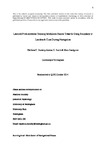Learned predictiveness training modulates biases towards using boundary or landmark cues during navigation
| dc.contributor.author | Buckley, MG | |
| dc.contributor.author | Smith, Alastair | |
| dc.contributor.author | Haselgrove, M | |
| dc.date.accessioned | 2018-02-19T15:39:15Z | |
| dc.date.available | 2018-02-19T15:39:15Z | |
| dc.date.issued | 2015-06-03 | |
| dc.identifier.issn | 1747-0218 | |
| dc.identifier.issn | 1747-0226 | |
| dc.identifier.uri | http://hdl.handle.net/10026.1/10820 | |
| dc.description | peerreview_statement: The publishing and review policy for this title is described in its Aims & Scope. aims_and_scope_url: http://www.tandfonline.com/action/journalInformation?show=aimsScope&journalCode=pqje20 | |
| dc.description.abstract |
<jats:p> A number of navigational theories state that learning about landmark information should not interfere with learning about shape information provided by the boundary walls of an environment. A common test of such theories has been to assess whether landmark information will overshadow, or restrict, learning about shape information. Whilst a number of studies have shown that landmarks are not able to overshadow learning about shape information, some have shown that landmarks can, in fact, overshadow learning about shape information. Given the continued importance of theories that grant the shape information that is provided by the boundary of an environment a special status during learning, the experiments presented here were designed to assess whether the relative salience of shape and landmark information could account for the discrepant results of overshadowing studies. In Experiment 1, participants were first trained that either the landmarks within an arena (landmark-relevant), or the shape information provided by the boundary walls of an arena (shape-relevant), were relevant to finding a hidden goal. In a subsequent stage, when novel landmark and shape information were made relevant to finding the hidden goal, landmarks dominated behaviour for those given landmark-relevant training, whereas shape information dominated behaviour for those given shape-relevant training. Experiment 2, which was conducted without prior relevance training, revealed that the landmark cues, unconditionally, dominated behaviour in our task. The results of the present experiments, and the conflicting results from previous overshadowing experiments, are explained in terms of associative models that incorporate an attention variant. </jats:p> | |
| dc.format.extent | 1183-1202 | |
| dc.format.medium | Print-Electronic | |
| dc.language | en | |
| dc.language.iso | en | |
| dc.publisher | SAGE Publications | |
| dc.subject | Spatial navigation | |
| dc.subject | Learning | |
| dc.subject | Attention | |
| dc.subject | Geometric module | |
| dc.title | Learned predictiveness training modulates biases towards using boundary or landmark cues during navigation | |
| dc.type | journal-article | |
| dc.type | Journal Article | |
| plymouth.author-url | https://www.webofscience.com/api/gateway?GWVersion=2&SrcApp=PARTNER_APP&SrcAuth=LinksAMR&KeyUT=WOS:000354456700011&DestLinkType=FullRecord&DestApp=ALL_WOS&UsrCustomerID=11bb513d99f797142bcfeffcc58ea008 | |
| plymouth.issue | 6 | |
| plymouth.volume | 68 | |
| plymouth.publication-status | Published | |
| plymouth.journal | The Quarterly Journal of Experimental Psychology | |
| dc.identifier.doi | 10.1080/17470218.2014.977925 | |
| plymouth.organisational-group | /Plymouth | |
| plymouth.organisational-group | /Plymouth/Faculty of Health | |
| plymouth.organisational-group | /Plymouth/Faculty of Health/School of Psychology | |
| plymouth.organisational-group | /Plymouth/REF 2021 Researchers by UoA | |
| plymouth.organisational-group | /Plymouth/REF 2021 Researchers by UoA/UoA04 Psychology, Psychiatry and Neuroscience | |
| plymouth.organisational-group | /Plymouth/Users by role | |
| plymouth.organisational-group | /Plymouth/Users by role/Academics | |
| plymouth.organisational-group | /Plymouth/Users by role/Researchers in ResearchFish submission | |
| dc.publisher.place | England | |
| dcterms.dateAccepted | 2014-10-08 | |
| dc.identifier.eissn | 1747-0226 | |
| dc.rights.embargoperiod | Not known | |
| rioxxterms.versionofrecord | 10.1080/17470218.2014.977925 | |
| rioxxterms.licenseref.uri | http://www.rioxx.net/licenses/all-rights-reserved | |
| rioxxterms.licenseref.startdate | 2015-06-03 | |
| rioxxterms.type | Journal Article/Review |


